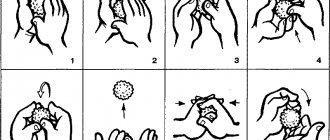Many parents strive to teach their little fidget to sit as early as possible, believing that this will help his further development and speed up the start of crawling. In addition, this important skill will allow the child to improve his visibility, free his arms, walk in an upright position in a stroller, sit with everyone at a common table in his highchair, master a walker... But what does all this really look like? Before thinking about the question of how to teach your child to sit independently, it is worth asking yourself another question: when can you start doing this?
When will we start sitting?
The position “as early as possible” is fundamentally wrong. Because, firstly, all children develop very individually: for some the norm is 5 months, but for others it’s too early to start at 7 months. And secondly, if the baby’s body is not yet ready to be in an upright position, we, adults, with our excessive “care” can provide him with many problems in the future (for example, scoliosis, pinched nerve endings, stoop).
A child’s spine is the basis of his entire musculoskeletal system. In this case, the emphasis should be on the first part of the word: the support should be sufficient for sitting. And this is precisely the baby’s spine, and not the pillows with which they “carefully” covered the little one, or the back of a highchair!
So at what age should a baby sit down? Modern pediatricians believe that, in principle, he owes us nothing. The approximate age for starting to master the skill of sitting is 5–6 months. From this time, as a rule, the child begins to receive complementary foods, and it is more convenient to feed him with a spoon in an upright position. However, gender plays a role here: girls begin to be planted no earlier than they are 6–7 months old, otherwise they can be “rewarded” with problems with the formation of the pelvic organs (for example, a curvature of the uterus).
Today in pediatrics the following general guidelines for the development of sitting skills have been adopted.
- At 6 months, the toddler can freely roll over onto his tummy. If you help him a little by holding out your fingers for him to grab, he tries to sit up.
- At 7 months, he can already sit for some time with a straight, level back on his own, without outside help or support, turn his body from side to side, and sit down on all fours.
- At 8 months, the baby can already sit and in this position reaches with his hands to a toy or other bright object that interests him.
- At 9 months, the baby can sit up independently from a lying position, as well as standing on all fours; moves from a sitting position to a position on all fours; can stand on support on his knees. Sits for a long time with a straight back. From a sitting position, with the help of support, tries to get up, can or tries to crawl.
How to help your baby crawl
The famous pediatrician Dr. Komarovsky, when asked how to teach a baby to crawl, answers that the child will stand, walk, sit and crawl on his own when he wants. The main role of parents is to raise him so that all the listed movements do not turn into hard work for the baby. The only help from adults should be hardening, muscle development and the prevention of rickets.
When the baby begins to crawl, parents need to learn not to limit freedom of movement. In order to protect the baby from troubles, the best way is to get on all fours, look around and check the space for sharp corners. If dangerous objects are visible, then you need to remove them so as not to turn the exploration of the baby’s world into complete prohibitions.
Sometimes, even after 8 months, the baby does not want to start moving independently. In this case, parents begin to turn to pediatricians with the question of how to teach their child to crawl. Children's doctors say unequivocally: there is no need to forcibly stimulate the movements of your child, because the baby may simply have a weakened body. First you need to undergo an examination and strengthen the musculoskeletal system with the help of special gymnastics. There are several factors that influence the formation of a baby’s desire to crawl:
- personal characteristics;
- health status;
- psychological situation in the family;
- physical data.
Exercises to make a child crawl
You can help learn to crawl through activities by placing children's books, bright toys, lids, and boxes on the floor to stimulate interest in exploration. But before that, you need to check whether the crumb is in the draft zone. To avoid colds, you should lay a carpet on the floor, place a mattress or a warm blanket. The absence of restrictions on independent movement will help teach the baby to crawl much faster. The baby will feel more confident if her mother is nearby while traveling.
How to teach a child to crawl using specially designed exercises:
- Support on straight arms. Place your baby on your stomach and hang your favorite toy slightly above your head. In order to grab an object, the child will rise on his arms and stretch.
- Strengthening the vestibular apparatus. You can teach how to work with your hands by making a bolster from a pillow or blanket, which is placed under the child’s chest. The head and arms should hang down, and the legs should be level. A child in this position will turn his head in different directions and take the objects he likes with both hands.
- Standing on knees and all fours. Press the baby to your stomach, clasp it under the armpits with one hand, and place the other on the surface with your knees. The baby's straight back should remain pressed to you. When the child gets comfortable, lower him slowly forward so that his arms rest on the surface.
- Learn to rearrange handles. It is better to conduct the lesson over a table. Hold the baby under your chest with one hand, and lift your legs with the other. With open palms, the baby should rest against the surface of the table. Push the child so that the arms begin to move forward on their own.
Is your baby ready to sit down?
However, the fundamental factor in order to begin planting the baby should be the readiness of his body for this. How to check if your baby is ready to sit? You need to watch him, checking the skills he has mastered.
If the baby is ready to sit down, then he has already learned:
- lie on your tummy for a long time;
- lying on your stomach, confidently hold your head, lift your chest from the support, firmly resting your arms;
- turn from back to side, come back.
But if the baby does not try to roll over from his back even onto his side, when trying to sit him down, he falls to the side, and if he sits, then with a round back - his body is definitely not yet ready for such changes.
How to determine whether this is an individual feature, or whether there is cause for concern? The presence of pathology is usually accompanied by obvious signs:
- when trying to sit a baby at 7–8 months, he immediately falls to one side;
- he has an obvious developmental delay (cannot hold objects, does not babble, does not smile, etc.);
- the baby often worries for no reason and is capricious;
- the baby has pronounced strabismus, he bulges or rolls his eyes;
- the child is underweight;
- he has increased or decreased muscle tone;
- The fontanel takes too long to overgrow.
How to teach a child to sit: is it necessary to teach him to sit?
The first question that you need to answer for yourself when teaching your baby something is: “Why does he and I need all this?” And only the second question that you need to ask yourself is: “How is this done?”
In this article I will answer these two questions in detail in relation to a child’s mastery of the ability to sit.
Why all this, or is it necessary to teach a child to sit?
Sitting is an action that a child learns after active crawling. Very often, adults strive for the baby to sit down as early as possible. And once, having attended a course at an Australian online institute, I was surprised to hear advice to cover the baby with pillows so that he would sit down early.
Is it correct? No! This is absolutely not allowed! Although the Internet is replete with advice like “sit your baby on the pillows” or “lean him on the back of the sofa until he learns to sit on his own!” But this is a direct path to… illnesses for the child, and very serious ones at that. And they will appear not now, but much later in life. There is no need to rush - everything is very precisely thought out by nature, and everything has its own time and time.
The main movement a baby needs for full development is not sitting, but crawling. It is active crawling that prepares the child for sitting, standing, and walking and contributes to the harmonious physical development of the child. And then sitting occurs naturally on its own when the child’s muscles and entire body are ready for it. Early sitting (when the child’s body is not yet ready for it) does not contribute to the future health of the child, although it touches many adults. When the baby’s body is ready, the child will sit up on his own!
It is very important to teach your baby to crawl correctly - that is, crawl on all fours, and not pull himself up on his hands. When pulling up, only the arms are involved in crawling, and the legs are weak as a result
How to encourage a child to crawl as a basis for further mastery of sitting:
1) Crawling after a toy placed at a distance from the child on the floor.
2) The game “I’ll catch up - I’ll catch up” with increasing crawling speed,
3) Crawling through obstacles (roller, pillow), going around an obstacle standing in the way of a toy (for example, a low bench).
4) Exercise for developing crawling “Frog”. The child lies on his stomach with his feet facing his mother. The mother holds - fixes the baby's feet from the back side so that her index finger is between the feet (girth of two feet from the back side, index finger between the baby's feet).
Then the mother bends and straightens the child’s legs - movements as if a frog is swimming - at the knee and hip joints. We do several of these passive movements. After this, we hold the child’s legs in a flexed position and give him the opportunity to push off on his own until the legs are extended and move forward. To stimulate a new repulsion, we place a toy in front of the child that is attractive to him.
As soon as the baby begins to actively crawl on his own, you can skip the exercise and provide him with a floor to move around.
The exercise develops the muscles of the back, spine, legs, arms and shoulder girdle.
What happens if we sit the baby down early and encourage sitting?
A child's weak back muscles tire easily. The child slouches heavily and begins to lean his chest on his stomach to distribute the load. This happens when we sit the child down, but his muscles are not yet ready for this body position!
The child does not need back support. When he is ready, he will sit down on his own, with a straight back. And if he gets tired, he will change his body position to a more comfortable one. In this regard, children are much more natural than adults and will not sit in an uncomfortable position.
Conclusion:
“It is active crawling that helps the child to actively sit down and stand up in the future and prepares him for these types of movements. Therefore, it is necessary to stimulate not sitting, but active crawling
. And give the baby room at home to crawl on the floor and the opportunity to crawl along the floor to a toy placed at a distance from him or to a source of an interesting sound. Moreover, the baby needs the floor to crawl, and not the playpen or sofa.
— The main task at the age of 6-10 months is to strengthen all the baby’s muscles with the help of crawling so that in the future he can easily sit, stand, and walk.
Reasons for late development
What can cause such deviations? The reasons may be different:
- difficult pregnancy (toxicosis, threat of miscarriage, Rh conflict, intrauterine infections, fetal hypoxia, anemia, prematurity, etc.);
- difficult labor (rapid or, conversely, proceeding with stimulation of labor, with the use of forceps; birth injuries to the baby);
- illnesses of the child as a consequence of the above problems (weak muscle corset, genetic disorders - Down syndrome or others, pathologies of the central nervous system, such as cerebral palsy, epilepsy; rickets, hip dysplasia, muscular dystrophy, obesity).
All these diseases in one way or another affect the proper development of muscles and bones and inhibit physical development. Therefore, the baby definitely needs timely treatment, otherwise, in addition to the lack of sitting skills, he will also show more serious signs of developmental delay.
Try to find a middle ground between forcing events and being too calm. You need to pay attention to your baby's ability to sit at about 7 months: after this, it is possible to diagnose problems that require early treatment.
A child may refuse to drop off due to hidden psychological trauma. Perhaps he once fell and was hit hard, or was dropped, and he was very scared. Now this fear blocks the baby’s desire to sit down. This will require parental patience, and possibly consultation with a child psychiatrist or neurologist.
Preparatory stage
In order for a child to start sitting on time, it is important to help him strengthen his bones and muscles. To do this, you need to regularly do simple gymnastics with him.
- For example, bathing in an adult bathtub filled almost to the brim with a special holding circle will help strengthen your abdominal muscles. At the same time, the baby will vigorously flounder, working with its legs.
- For hyper- or hypotonicity, a special massage will help. You may need specialist help.
- Crawling on your belly strengthens your spine, abdominal and leg muscles. Therefore, it is important to encourage the child to crawl by offering to reach for an interesting toy. You can place your palms under his heels for support - let him push off, strengthening the necessary muscles.
- Frequent tummy time also helps strengthen the back and spine muscles. Let the baby play in this position with his favorite rattles longer.
- Large cells on the mesh of the playpen will easily teach the baby to grab onto them, pull himself up, and rise. All this is training and strengthening muscles.
If your child does not yet know how to sit, do not carry him in a kangaroo for more than half an hour - this is an almost unbearable load on the still fragile spine. The same applies to the stroller: you don’t need to carry your baby in it in a sitting position. It is better if the stroller is equipped with a rigid backrest that reclines to a “reclining” position.
Strengthening the muscles of the back and neck
What exercises are needed to make a child sit? First of all, it is necessary to consider a complex aimed at strengthening the muscles of the back and neck.
Push ups:
- Spread a blanket on the floor.
- Place the baby on his tummy.
- The baby will try to rise with the help of his hands, lifting his chest off the floor.
By repeating these unique push-ups, the baby’s back will become stronger each time.
Consider the following exercise:
- Using a blanket on the floor, place your baby on her tummy.
- Place various toys at a distance of 30 centimeters.
- The baby, having become familiar with the goal, will crawl towards the toys.
Crawling uses all the muscle groups needed to sit independently. It is enough to perform a set of such exercises 2-3 times a day, and soon the training will give excellent results.
Important Rules
If a child already demonstrates physical readiness to learn to sit, but he can’t do it on his own, the parents’ task is to help him. There are many different exercises to help teach a child to sit independently.
In order for the classes to bring only benefits and positivity to your child, you need to follow a few simple recommendations.
- A child should be cheerful and healthy before gymnastics.
- You can start doing exercises no earlier than an hour after eating.
- Before starting classes, the room must be ventilated.
- The baby’s muscles need to be warmed up with a light massage for 5–7 minutes.
- Light clothing is needed, made from natural fabrics (diapers will have to be removed).
- Gymnastics should be carried out on a hard surface - good support will help the baby better feel balance.
- While doing the exercises, you need to constantly talk and play with the child - this will provide positive emotions, which, in turn, will only speed up learning.
- Each exercise should be performed smoothly, without jerking or sudden movements, to avoid injury.
- You should not overload your child by including as many exercises as possible in the complex. 3-4 with a total duration of no more than 15 minutes will be enough. You need to start with 2-3 repetitions, gradually increasing their number to 6-8.
Moms' concerns: what to do if the child does not want to sit?
Many mothers begin to worry if the baby does not meet generally accepted standards in physical development and think about how to teach the child to sit independently. Shouldn't you start sitting your baby up?
Most often, the baby learns new skills on his own and just needs time. If the baby does not begin to sit by 11 months, you should contact a good pediatrician.
Until this time, there is no need to worry; it is better to help the child’s body get stronger. Regularly do gymnastics with your child, carry it correctly in your arms, allowing your back muscles to become stronger.
While sitting at the table and feeding your baby, you can hold him in a position that helps train your back. You will learn how to do this correctly from the course on introducing complementary foods to your baby.
You can place your baby on his stomach more often and place toys in front of him so that he can reach for them.
Parents should help their baby develop physically from birth. Often a course of restorative massage helps a child learn to sit.
It is better to carry it out to a specialist. The results will be visible immediately. This massage is performed to provide the necessary impetus to the child’s physical development.
ADVICE FROM EXPERIENCED MOMS:
When should you be concerned?
Sometimes the reason why a child does not sit at 8 months is a delay in psychomotor development. Then you need to urgently contact a neurologist. The inability to sit is not the only sign and is most often a consequence of:
- fetal hypoxia;
- early birth;
- anemia during pregnancy;
- fetal prematurity;
- intracranial pressure.
Training exercises
So, the following exercises will help your baby sit up on his own.
- Place the baby on his back on the floor with a warm blanket on him. Take him by the feet and reach his nose with your toes, without bending your knees.
- Let's modernize the first exercise: we hold the legs, not reaching the nose, to stretch the muscles.
- The position remains the same - lying on your back. You need to give the baby your index fingers so that he can grab them tightly and fixate himself. Slowly pull it up to a vertical position - plant it. Smoothly return the child to the original, lying position.
- Now you need a different starting position - lying on your tummy. You need to help the baby roll over onto his back and then go back. You can attract him with a bright toy so that he reaches for it, turning over on his own. We help the baby by lightly pushing his feet with our palms.
- This exercise can be done by three people - using dad for backup. If this is not possible, special spring pillows will do. You need to sit the baby between the pillows (or dad's arms). You need to hold the baby’s legs with one hand, and hold his palms with the other. In this position, the baby is gently rocked in different directions. This trains the ability to balance (maintain balance) and perseverance.
- An adult sits on the floor with legs spread wide apart. The baby is placed between the legs with his back to himself, and a large bright toy is placed in front of him, which the child can comfortably grab onto. When he firmly grasps this support, he is lifted off the floor a little and slowly rocked from side to side. This strengthens the muscles of the spinal corset.
- When the training exercises are mastered, the child can be placed on an adult’s lap, giving him his fingers for support. Being in this position, the child trains muscles and balance, so he can quickly learn to sit independently.
The skill of sitting is one of the milestones in a child’s development. After all, he gets the opportunity to have a wider view, can handle toys (this is much more comfortable than lying on his tummy), and walk in a “sitting” stroller. Feeling the joy of the new position, the baby will quickly advance to the main skill of the first year of life - independent walking. Well, if the baby is a little indecisive in his actions and does not dare to sit down on his own (or does not understand how to do this), adults will always help him. After all, it’s not difficult at all.
What to do if the child has not learned to sit down?
Up to 8 months
We have already said that most children sit up by 7-8 months, so mothers and fathers of a still “lying down” child should not panic, cry and wring their hands before this time.
It’s better to try to speed up the long-awaited process by sitting the child in a chair or on your lap, but so that he has good support on his back.
After a while, you will notice that the baby is trying to sit up on his own, and after a month you will understand that he is already confidently and with a sense of self-esteem sitting on a soft surface, scrolling from side to side, and examining the surrounding space.
At 8 months and older
But if your baby is already 8 months old, and he doesn’t want to sit or he can’t sit down on his own, you need to seek help from specialists. Sometimes it also happens that at the age of nine months, a child, getting up in the playpen, begins to cry instead of sitting on his bottom and resting.
This is normal, because many children during this period cannot sit up from a standing position. They will master this important skill closer to 10 months, but if the baby does not learn this even at 11 months, be sure to consult with your pediatrician on this issue.











